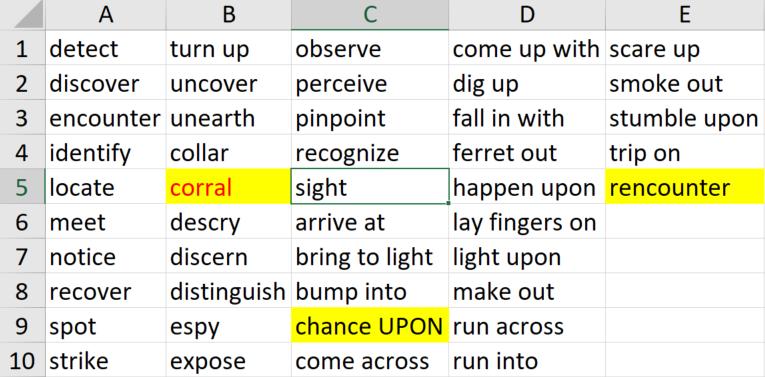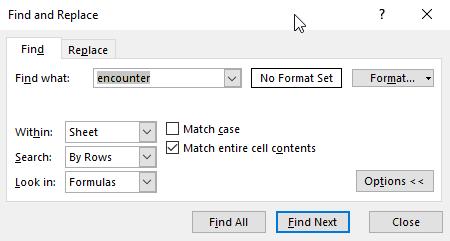VBA Blogs: Finding the Part of a Whole
1 June 2018
Last week we looked at using the After, SearchDirection and SearchOrder parameters of the Find method.
What if we needed an exact match? There’s a few things we could match.
- Matching the complete word
- Matching the case of the word (i.e. the capitalisation)
- Matching a specific cell formatting
Luckily, the Find method has parameters that can help us with that! Today’s article will look at the first option. Not to worry, we will cover the other options in later weeks!
The word field has been adjusted slightly to give us more interesting things to search (the changed squares are highlighted in yellow):

Matching the complete word
If we were to search “encounter” from C5 what would the result be? Let’s give it a go:
Sub EncounterOfTheFirstKind()
Dim searchRange As Range
Set searchRange = Range("A1:E10")
Dim foundrange As Range
Set foundrange = searchRange.Find("encounter", After:=Range("C5"))
If foundrange Is Nothing Then
Debug.Print "not found!"
Else
Debug.Print foundrange
Debug.Print foundrange.Address
End If
End Sub

It technically found ‘encounter’ but within ‘rencounter’. To force it to match the complete word, we would need to trigger the LookAt parameter. By defining it to be xlWhole, that will force it to look at the entire contents of the cell.
Sub FindWholeWord()
Dim searchRange As Range
Set searchRange = Range("A1:E10")
Dim foundrange As Range
Set foundrange = searchRange.Find("encounter", After:=Range("C5"), LookAt:=xlWhole)
If foundrange Is Nothing Then
Debug.Print "not found!"
Else
Debug.Print foundrange
Debug.Print foundrange.Address
End If
End Sub
This change will land on the expected answer of cell A3.

Now, this is where things get interesting. If we were to run another search immediately after without the LookAt:=xlWhole portion, it would still maintain the parameter setting. This is because Excel saves this setting in the Find dialogue. Opening the dialogue up, view the advanced settings by clicking the "Options > >" button:

There it is! So whenever doing a search using the Find method in VBA, ensure that you always set the parameters for each Find because otherwise it will lead to unexpected results.
Come back next week where we will keep finding things on a Case-by-Case basis!

